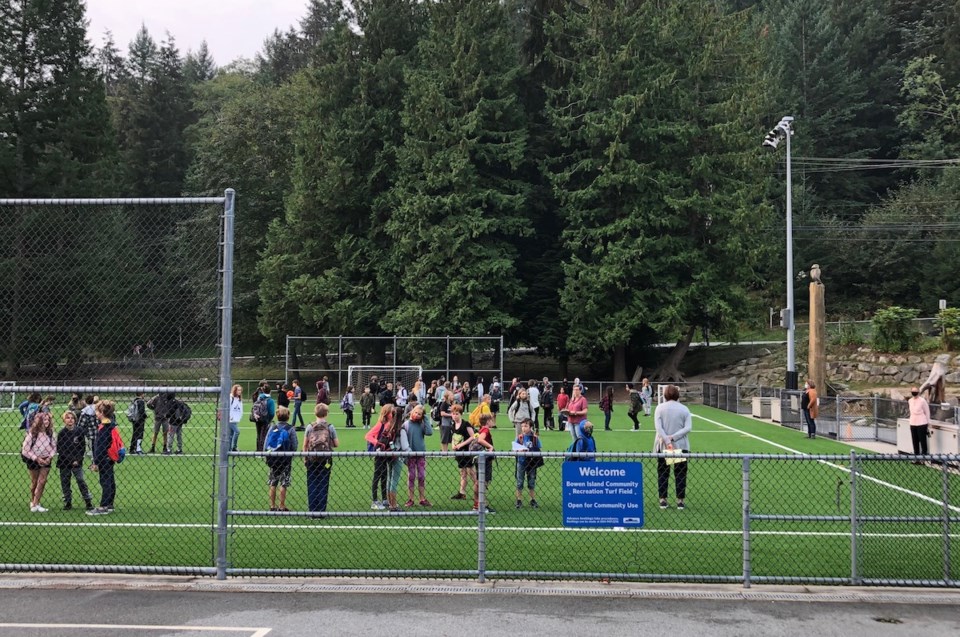Before school started last week, a certain level of anxiety was to be expected.
Will students be safe? Will staff be safe? Will the pandemic protocols be enough to prevent the spread of the novel coronavirus?
“It's hard to think of taking a risk when you don't have the benefit right in front of you. Now that the kids are in the building, we have that benefit,” says Scott Slater, the principal of Bowen Island Community School. “We have happy students and we have learning happening.
“There's a really good feeling in the school of gathering together as a community. People are feeling connected to both their classroom and school community; we need connections when we're going through something like this.”
Parents spent the summer deciding, given their individual circumstances, what was the best — and safest — learning environment for their child.
About 300 students are taking in-school classes, Slater says of the fall enrollment numbers. That’s a slight decrease. Approximately 25 students, primarily in Grades 4 to 7, have opted to learn outside the school walls.
“There are definite trends of older students choosing distributed learning, as well as homeschooling, potentially because those children might be able to engage in those aspects of education more easily,” Slater said, noting parents have not necessarily shared their reasons.
With distributed learning, the family creates the learning plan, figures out the objectives and how they're going to get there, he says. The family is attached to the school district and there is some organization from a remote teacher who’s providing guidance and some online instruction.
Another option is the school district’s temporary transition plan. “They participate in remote learning through our school district and we save a spot for them in our classrooms so that when they wish to return we have space for them.”
On Bowen Island, parents also have the option of enrolling their students in the Island Discovery Learning Community. Its distributed learning program is publicly funded by Powell River Board of Education and offers a teacher-led, flexible and family-centred program for students in Kindergarten to Grade 12.
At BICS, the smaller enrollment has made it easier for students to reduce physical contact.
“Even though we have gone from 15 to 14 divisions, we actually have a lot of our classrooms with lots of room in them right now,” Slater says. “It’s not a bad thing to have just a little bit under what is required upper limit of students. For kindergarten, the maximum is 20 students per classroom, in primary it is 22 and for intermediate it’s 30. We're under in all of those categories and sometimes quite significantly. So even though kids don't have to physically distance in a classroom [as part of the West Vancouver School District’s health and safety elementary school protocols], there's a little bit more space to just spread out a little bit.”
Slater says the comfort level is increasing every day.
“We're in this for the long haul so all the protocols such as daily health checks, washing hands when they come in the building and leave a learning space and practising respiratory etiquette can get kind of mundane and tiresome. We just need to make sure that we're being careful, not complacent. But the kids have been co-operative and totally understanding of why we're doing what we're doing, which is really important.”
One protocol that isn’t part of the pandemic response is what to do now that wildfire smoke from Washington and Oregon has resulted in air quality health advisories. “Metro Vancouver advisory is to avoid vigorous outdoor activity, which is what we’re doing,” Slater says. In a school day, the students have about 35 minutes of outside time, which is on par for how much time they are outside getting to and from school.
It’s important to let students have some outdoor play time but activities are at a much slower pace. “We might have to clamp down if this lingers or gets worse, but for now the kids are playing outside,” he says.
In the meantime, he thanks the community for helping the school create a safe environment for students and staff.
“The beauty of the school system is that it's a controlled environment. The people coming through our doors are the same people. They’re all getting the same information and encountering the same protocols. We also have parents’ support in making sure that, as best as we possibly can, students who are exhibiting any symptoms are not coming in.”
As a result of creating this controlled environment, the school site is currently closed to community from 8:15 a.m. to 3:15 p.m.. Only students and staff are allowed on site during those hours. But the playground, playing fields and access to recreation programming are all available outside school hours.
“Our playground is the community playground,” Slater says. “I want people to still see our school as a great asset to the community.”
As to predicting whether the school will have to be closed some time during the year if infection levels rise beyond a comfortable level, Slater says the decision isn’t up to BICS or the school district.
“It's hard to know because it's so contingent upon the public health measures in B.C.. Provincial health officer Dr. Bonnie Henry has made it clear that the most important things that keep people safe aren't so much the administrative measures that we have in the school setting, but the public health measures in the province. So it really depends on the overall state of what it looks like in British Columbia. Hopefully the numbers trend the right way and that keeps everyone safe.
“We do our very best to make sure we're doing everything right and as best we can, but we're obviously within the setting of the province.”
Martha Perkins is the North Shore News’ Indigenous and civic affairs reporter. This reporting beat is made possible by the Local Journalism Initiative.



